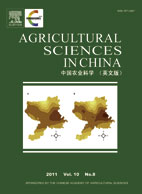|
|
A Field Study on Effects of Nitrogen Fertilization Modes on Nutrient Uptake,Crop Yield and Soil Biological Properties in Rice-Wheat Rotation System
GUAN Guan, TU Shu-xin, YANG Jun-cheng, ZHANG Jian-feng, YANG Li
2011, 10(8):
1254-1261.
DOI: 10.1016/S1671-2927(11)60117-X
Rational application of nitrogen (N) fertilizers is an important measure to raise N fertilizer recovery rate and reduce N loss.A two-year field experiment of rice-wheat rotation was employed to study the effects of N fertilization modes including aN fertilizer reduction and an organic manure replacement on crop yield, nutrient uptake, soil enzyme activity, and numberof microbes as well as diversity of microbes. The result showed that 20% reduction of traditional N fertilizer dose of localfarmers did not significantly change crop yield, N uptake, soil enzyme activity, and the number of microbes (bacteria,actinomycetes, and fungi). On the basis of 20% reduction of N fertilizer, 50% replacement of N fertilizer by organic manureincreased the activity of sucrose, protease, urease, and phosphatase by 46-62, 27-89, 33-46, and 35-74%, respectively, andthe number of microbes, i.e., bacteria, actinomycetes, and fungi by 36-150, 11-153, and 43-56%, respectively. Further,organic fertilizer replacement had a Shannon’s diversity index (H) of 2.18, which was higher than that of other modes ofsingle N fertilizer application. The results suggested that reducing N fertilizer by 20% and applying organic manure in theexperimental areas could effectively lower the production costs and significantly improve soil fertility and biologicalproperties.
|
